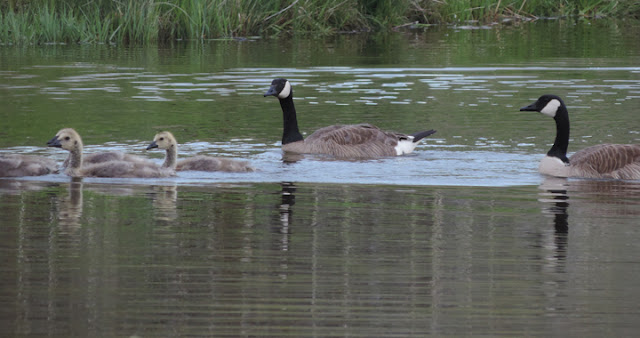Please see the previous post for more information about our pond at the Wyoming studio.
Canada Geese return to our pond every spring to nest, breed, molt, and raise their young.
Typically, the same pair return year after year to where they previously nested and found a safe haven.
They find shelter on secluded ponds like ours which provide security from predators. This year, we have two different mated pair of Canadas who are raising their young on the pond's island and the surrounding fringe cover.
While the two families don't interact much, below is a image of the two mated pair with their young taken this morning.
When Canada Geese molt, they lose their primary flight feathers in early summer and become flightless until new feathers grow in about mid-August. Being flightless is nature's way of causing the pair to breed and stay with their young . . .
protecting them from harm and teaching them to fly at the end of summer, away from the frigid Wyoming winter.
Most large birds like Canada Geese mate for life and it's a thrill to hear them arrive at our pond every spring.
There's a fascinating website about the molt and migration entitled: www. geesepeace.com
Below, is a photo of primary flight feathers at the edge of our pond . . . evidence of the molt.
Most large birds like Canada Geese mate for life and it's a thrill to hear them arrive at our pond every spring.
There's a fascinating website about the molt and migration entitled: www. geesepeace.com
Below, is a photo of primary flight feathers at the edge of our pond . . . evidence of the molt.
Also shown, is a drawing of a wing showing the primary flight feathers that will molt and quickly grow back again.
There's an old cabin next to the pond where we throw out a scoop of corn for the geese.
Below, a Mule Deer doe walked into view as the geese waited for their corn this morning.
Below, are additional images of the Canada Geese on our pond with their young.
Note: Canada Geese have long been a favorite subject for my art, both etchings and sculpture. . .
I named the book about my work - "Spirit of the Wild Things", published in 1998 - after an early
monumental sculpture depicting Canada Geese with the same title.
Below, is an image of the above mentioned monument, an image of the book cover, and a link to the book -
"Spirit of the Wild Things - the Art of Sandy Scott". The book is still available for purchase.
http://www.SpiritOfTheWildThings
Go to the BLOG INDEX on the right for more information.
Blog, text, photos, and sculpture . . . © Sandy Scott and Trish






















































